




Since the first tests carried out by Marc Grégoire in the late 1950s, Tefal has constantly evolved and is now a world leader, not only in non-stick frying pans, its flagship product launched to great acclaim in 1956, but also in many other cooking products and small electrical appliances. The recipe for this success: constant innovation. Tefal has always striven to listen to consumers and anticipate changes in their lifestyles in order to offer products suited to their needs.
Tefal has kept up with two essential phenomena. First of all, the kitchen's role in the home has totally changed. It has become the shared central focus for the whole family, the place where people come together, talk and welcome guests. At the same time, our relationship with food has undergone a profound transformation. Preparing a meal is no longer a burden – cooking has become a pleasurable experience. Today, Tefal produces 50 million products and the brand has a presence in over 120 countries.
Tefal aims to remain a symbol of innovation, and seeks to anticipate the developments that will revolutionise the home in order to imagine the essential items of the future in the kitchen and throughout the house. Technological developments and consumers' expectations provide a glimpse of some exciting prospects: the connected kitchen, user support, the trend for ever-healthier food, more powerful robotics… These are all areas where Tefal is committed to offering surprises.
"Tefal aims to remain a symbol of innovation, and seeks to anticipate the developments that will revolutionise the home."

Colette Grégoire, wife of the Tefal inventor"If your PTFE is as wonderful as you say, use it for something useful. Make me a pan the milk won’t stick to!"
The economy is doing well, consumption is booming and new icons are a breath of fresh air.
Marilyn Monroe and Grace Kelly are inspiring a model of femininity focused on pleasure and freedom. In all fields, there is a determination to break free from the constraints of the past and embrace a modern, relaxed lifestyle.
This is the background against which Marc Grégoire, a French engineer, is preparing to revolutionise the daily lives of cooks everywhere…
 innovation
innovationMarc Grégoire patents his “non-stick frying pan” in 1954. His innovative concept is a process for coating an aluminium disc with PTFE by treating it with hydrochloric acid. The result is a totally non-stick pan that makes cooking simple and enjoyable.
Marc Grégoire opens his first factory in Sarcelles in the Paris suburbs and chooses the brand name Tefal. His factory produces 100 frying pans a day in its first year.
In 1961, Jackie Kennedy, the new fashion icon, is photographed leaving a New York store with a Tefal frying pan in her hand.
The image is seen around the world and gives the brand an international dimension.
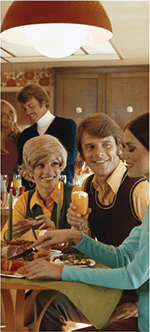
Terence Conran, English designer"The kitchen is no longer a room where people meet out of necessity, but for pleasure."
The kitchen has become the nerve centre of the home for the whole family. It is the room where we meet for breakfast, we talk over lunch and we welcome guests in the evening. In many countries, the concept of the open-plan kitchen and living area has taken hold.
Tefal widens its range of products and enters the small electrical appliance market.
 innovation
innovationIn 1968, SEB - soon to become Groupe SEB, the world leader in small household equipment - acquires Tefal and its five European subsidiaries.
Tefal’s expertise, including the non-stick coatings that are the company’s trademark, are now applied to products from the Group's other brands.
As the women’s liberation movement spreads through most developed countries, advertisers exploit the theme to emphasise the time women can save by using new electrical appliances.

Bernard Loiseau, French chef (3 Michelin stars)"The table is the ideal hub for relaxation and socialising!"
Welcoming guests has never been such a pleasure. Although the tradition of Sunday lunch is being eroded, new opportunities for sharing friendly meals, whether ordinary or more festive, are being imagined. Buffet meals and brunches are now eaten with family or friends at the kitchen table or in the living room.
The table is not just a place to communicate with each other.
Tefal responds by creating a range of products dedicated to entertaining…
 innovation
innovationWith the l’appareil à fondue électrique With the raclette grill with non-stick pans (1975), the electric fondue set (1990), Tefal invents a new way of sharing meals: preparing them directly at the table with the focus on fun.
Working with tourism professionals, restaurant owners and cheesemakers, Tefal plans to bring raclette cheese from Savoie to a wider public. Thanks to its dedicated appliance, the rise of raclette takes it beyond national borders, and the raclette grill becomes an essential accessory for winter meals.
Even a president loves a friendly meal! In 1975, Valéry Giscard d’Estaing, the newly elected President of France, decides to meet his “ordinary fellow citizens”. And what better way than by inviting himself to eat with them, in their kitchens?
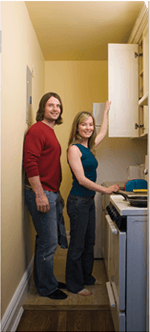
Monique Eleb, Sociologist, Professor a the 'École Nationale supérieure d’architecture'* in Paris (*French Public Higher Education Establishment for Architecture)"The average size of our homes has not grown. Optimising the use of space is thus a priority."
Although homes are no larger, the number of appliances we use is multiplying. To save space, domestic appliances have to become more functional, smaller and more convenient.
This is the decade of the microcomputer, the first game consoles and ergonomic household appliances…
Tefal continues to diversify its activities and spreads to other rooms in the house.
The brand launches kitchen scales and offers simple, practical new appliances such as irons.
 innovation
innovationTefal launches its Supergliss steam iron (marketed in France under the Calor brand) with a soleplate made of Durilium, a new coating that eliminates scratches, dirt build-up and stickiness.
This small, practical, mass-market appliance makes ironing more accessible.
Tefal launches “Ingenio”, a range of kitchen utensils with an ingenious system of removable handles which facilitates storage.
In the mid-1980s, Apple launches the Macintosh, one of the first micro- computers aimed at the general public.
Its single-box design emphasises user-friendliness, style and compactness.
It is an immediate commer- cial hit, and its success inspires a wide range of products.

Perla Servan-Schreiber, author of “Le Bonheur de cuisiner" (“The Joy of Cooking”)"When I get home after a day at work, I feel a profound need to start cooking. It’s my way of leaving behind the world of appearances and recharging my batteries."
More and more people enjoy “home” cooking: 94% of French people see cooking a meal as a source of pleasure and fulfilment, while only 6% see it as a necessity or a burden.
Cooking lessons are over- subscribed, cookery books fly off the shelves and everyone wants to get into the kitchen!
Tefal supports beginner chefs by continuing to offer products that make it simple to prepare good food and get perfect results…
 innovation
innovationTefal creates a new innovation for its frying pans: the Thermo-Spot.This heat indicator changes its appearance depending on the temperature of the pan.
With this new tool, cooks can now see when the pan has reached the right temperature. Cooking has never been so simple, even for beginners!
During the 1990s, the BBC launches one of the first reality TV shows dedicated to cooking: MasterChef.
Adapted in over 40 countries, the concept announces a new golden age of TV cooking and kickstarts a fascination with the culinary arts!

Oprah Winfrey, one of the most influential women in the world, posts a photo of herself with a T-fal Actifry"This machine…T-Fal Actifry has changed my life. And they’re not paying me do say it."
The aspiration to eat a healthy, balanced diet has never been so strong.
Campaigns to raise awareness are everywhere, organic labels are increasingly popular and people are flocking to sign up for vegetable boxes.
Consumers worldwide want to enjoy their food while favouring a healthier diet.
Tefal takes these concerns on board and launches its revolutionary fryer Actifry…
 innovation
innovationThe new family-format fryer ActiFry enables anyone who loves their food to prepare fries and other meals with just one spoonful of oil!
Supplied with a book of recipes overflowing with practical dietary tips, this versatile appliance can also be used for more elaborate recipes.
In 2010, T-fal is named Brand of the Decade in Japan by the Nikkei Business Publications Brand Consulting firm, beating 1500 other local and foreign brands.
In 2010, Michelle Obama launches a national anti-obesity campaign called Let’s Move!, inviting Americans to exercise more and eat more healthily.


“T-fal ingenio collection is amazing! The lids collapse! Genius! #clicktocook”
“@TefalUK My Fresh Express is the best thing ever! Love it.”
“@johnlewisretail @TefalUK see what the Cuisine Companion can do...love my Cuisine Companion :)”
“I have one of these. http://optigrill.tefal.co.uk/ They make meat taste amazing. If you are a meat-lover too, then you need one of these. #gadget”
“Really happy about my new Tefal product! Tonight beef Bourguignon and onion soup”
“Seriously happy I have this wonderful Cook4Me machine from @TefalUK to make dinner for me.”
“@Tefal Pro Express has the most steam pressure of a domestic steam generator iron. Loving the finish it gives my tailoring alterations!”
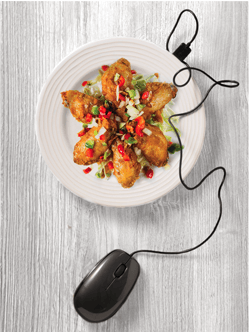
Ludovic Le Moan, founder of the Sigfox company."The Internet of Things probably represents an even bigger source of business opportunities than the Internet itself in its day."
Most domestic appliances are now “connected” – you can use your smartphone to control your soup cooking, the drying of your clothes and the watering of your plants.
A multi-purpose remote control for the home, the smartphone enables household appliances to be fully optimised. Their features are multiplied and adapt perfectly to the needs of every member of the family.
 innovation
innovationFollowing Cookeo Connect et Actifry Smart, Tefal will be launching connected products in almost all categories in the coming years.
Products designed to make consumers’ lives easier and achieve optimum results.
According to a study by GfK, tow milliards d’objets connectés devraient se vendre rien qu’en France d’ici 2020, when every home will have on average 30 connected objects.

Dickson Despommier, microbiologist,"The best way of feeding everybody in the next 50 years is to produce food where most of us live – in cities."
The planet has over nine billion inhabitants, of whom 80% now live in cities.
To feed all these mouths, the agricultural model has been turned upside down.
More and more city-dwellers are taking back responsibility for food production, cultivating fruit and vegetables at home.
This gives them the benefit of fresh, healthy produce all year round.
 innovation
innovationWe can imagine multi-purpose machines that will be used to cultivate, process and prepare home-grown food.
The whole food chain could thus be incarnated in a single domestic appliance that would take the food from harvest to plate.
According to the FAO (the United Nations Food and Agriculture Organization), 800 million city-dwellers worldwide already practise urban agriculture in their kitchens, on their balconies or on the shared roofs of their buildings.
This figure is set to triple by 2050.
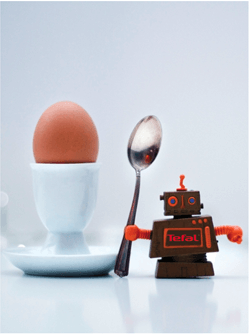
Bruno Maisonnier, former director of Aldebaran Robotics"The most important role for robots will be to act as sensitive, benevolent companions who will improve our daily lives. They will give us joy, surprise us constantly and help us to progress."
Domestic robots are reaching unprecedented levels of precision – and every home can now own a robot assistant worthy of NASA!
In the kitchen, the robot takes over from our arms to handle pans and ladles.
Completely devoted, it devises advanced menus every bit as good as our grandmothers’ cooking!
 innovation
innovationEngineers working for NASA have already created two robotic arms suspended above a cooker that can reproduce the movements of a professional chef very precisely.
The robot can choose its utensils, stir the soup, adjust the temperature, add spices… According to the researchers, a robot like this could be available to the public at an affordable price within about ten years.
According to the analysts at Grand View Research, 18 million domestic service robots will be sold in 2020.
This number should rise by 20% a year from then on.
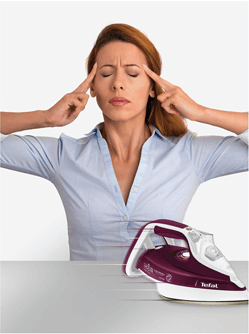
Niall Firth, journalist for New Scientist"Developments in electronic interfaces controlled by the brain are advancing at breakneck speed. The next stage will be controlling an iPad with thought alone. From there, the prospects are infinite!"
Now well developed, brain- computer interfaces (BCIs) make it possible to control everything – not with a phone or a remote control, but directly with our brains!
We put on virtual reality headsets, wear sensors directly linked to the cortex (or even electrodes implanted in the brain) and control all the appliances in our homes with the power of the mind alone!
 innovation
innovationA new generation of appliances is emerging.
From the comfort of the sofa, the user can activate the iron in the laundry room, visualise the pile of clean clothes and operate the iron remotely using robot arms to do the work.
All that’s left is to put the clean clothes away!
Professor Bin He at the University of Minnesota has already successfully flown a thought-controlled drone in 2013, using sensors placed on the subject’s head.
The success of the experiment convinced him that within 30 years it will be possible to control most appliances using the senses.
delivery.information.popup.text1
shipping.logistician.extlog
shipping.logistician.saplog
delivery.information.popup.text2
Login

Vis betingelser for produktgaranti

Find et servicecenter















